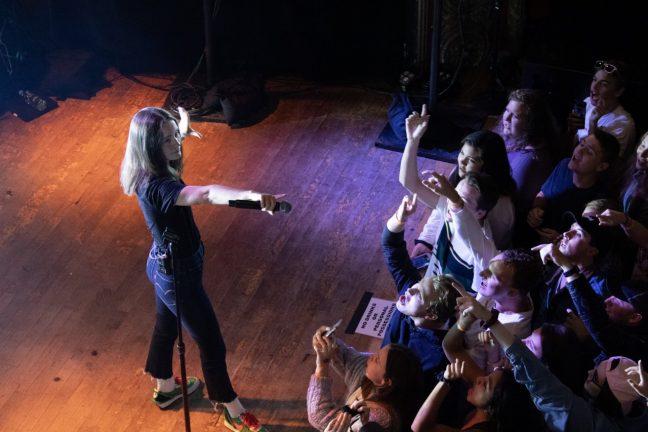
One minute you’re staring at a blank wall. The next you’re ant-sized, looking up at flowers that seem to loom feet above your head, trying to brush away blades of grass that are dangerously close to your face. Of course, your hands go through the blades; they hit only air, unless you really reach, and then they hit plexiglass. You fly through space, rising in altitude and increasing in size, until you can see fireworks overhead and the garden you once inhabited down below. At least, you see that unless you look behind you into the darkened room where four people and their computers sit at a table not 10 feet away.
If art is too expensive to view in its best form, should the viewer be impressed? This is the paradox presented by <1>:”der”//pattern for a virtual environment now on display at Wisconsin Institute for Discovery. The exhibition is a series of immersive, three dimensional environments created by photographer and artist Lisa A. Frank (the Madison native, not the Lisa Frank of second-grade girls’ social studies folder art fame). The environments are projected onto the $2.5 million dollar Cave Automatic Virtual Environment (CAVE) environment in the basement of WID and viewed through special glasses by groups of between six and eight people, plus a guide, in 15 minute increments.
The environments, such as they are, are spectacular. Frank uses objects found in nature to create complex pattern-based designs that are remarkably easy to get lost in. The overall effect of her work (in still or virtual form) is like peering into a kaleidoscope while sitting in the woods. It’s an effective literal twist on the old nature-as-patterns idea that math textbooks love to reference, but acres more visually arresting than a pen drawing of the golden ratio as found in a nautilus shell.
Her work is well suited for the CAVE environment, but the presentation is dampered somewhat by caution and setting. WID is, after all, a research facility, and its assets in this case are protected to the detriment of the artwork. As was explained to the group, the environment is projected onto three sides of the ten-foot plexiglass cube, then reflected to the top and bottom via mirrors (the fourth side is missing so people can enter and leave). Advanced glasses make images pop out from all sides in similar fashion to a 3D movie and track the images so that a sense of perspective is maintained at all times.
The problem is there’s little room to explore. Since the display would be confused if multiple perspectives had to be maintained, the tour guide keeps the master bar (the one for which perspective is always maintained; think of it like the tracker you put on your TV stand in order to use a Wii) at his own eye level at all times. This means the best, most distortion-free view of the room is through his glasses. It’s clear that the keepers of the exhibit don’t trust people to view it by themselves – there are about four checkpoints and a locked door barring entry to the environment – but the artistic experience suffers as a result.
Still, the overall experience is mindopening, worth the visit and quite clearly dripping with potential applications. The guide mentioned that CAVE and other similar systems have been used in connection with elderly assisted living environments as well as architectural simulations to move in space through interiors before they’re finished. The ways it could be applied artistically, one would imagine, are similarly diverse – though it seems like a similar (if slightly less immersive) concept has already emerged in the form of 3D IMAX. However, for CAVE to become an effective gallery viewing experience, there remain major hurdles to clear.



















